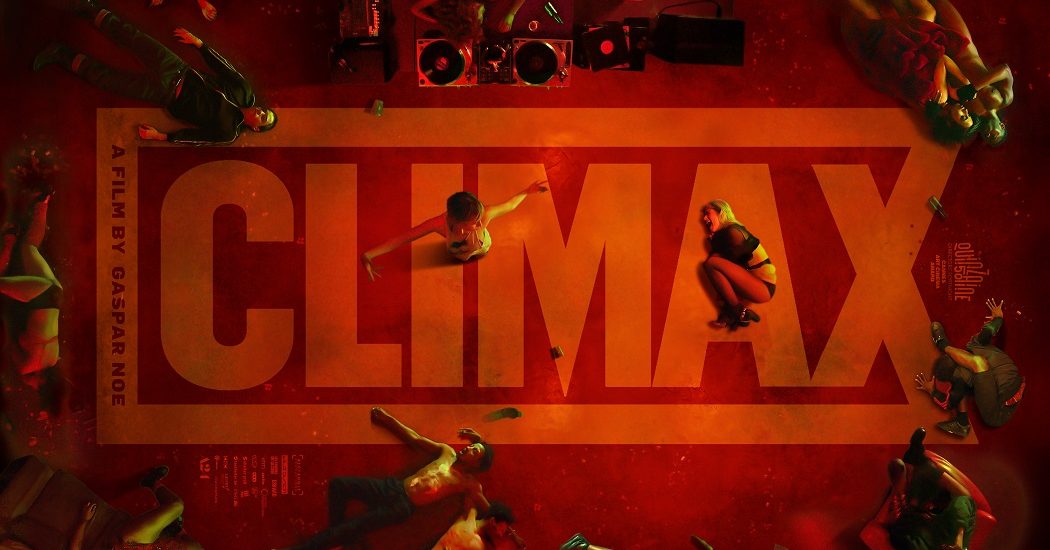
Climax Review: Gaspar Noé Attacks the Senses With a Loud Soundtrack and Flashing Imagery
Put simply, Climax finds Gaspar Noé being Gaspar Noé again.
Release Date: March 15, 2019
MPAA Rating: R
In Gaspar Noé’s Climax, French dancers gather in a remote, empty school building to rehearse on a wintry night. The all-night celebration morphs into a hallucinatory nightmare when they learn their sangria is laced with LSD.
Director: Gaspar Noé
Screenwriters: Gaspar Noé
Producers: Brahim Chioua, Richard Grandpierre, Vincent Maravel, Edouard Weil
Cast: Sofia Boutella (Selva), Romain Guillermic (David), Souheila Yacoub (Lou), Kiddy Smile (Daddy), Claude Gajan Maull (Emmanuelle), Giselle Palmer (Gazelle), Taylor Kastle (Taylor), Thea Carla Schott (Psyche), Sharleen Temple (Ivana), Lea Vlamos (Lea), Alaia Alsafir (Alaya), Kendall Mugler (Rocket), Lakdhar Dridi (Riley), Adrien Sissoko (Omar), Mamadou Bathily (Bats), Alou Sidibe (Alou), Ashley Biscette (Ashley), Mounia Nassangar (Mounia), Tiphanie Au (Sila), Sarah Belala (Sara), Alexandre Moreau (Cyborg), Naab (Naab), Strauss Serpent (Strauss), Vince Galliot Cumant (Tito)
Editor: Denis Bedlow, Gaspar Noé
Cinematographer: Benoît Debie
Production Designer: Jean Rabasse
Production

Gaspar Noé is best known as the writer/director of the 2002 thriller Irreversible, with its unconventional narrative structure and its brutal, unflinching rape scene. It’s safe to say that the French filmmaker has a certain style, and he does not let up with his newest movie, Climax.
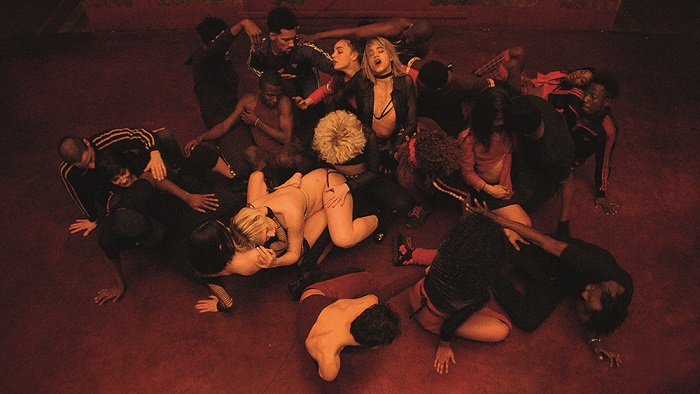
Set sometime in the mid-nineties, Climax is about a troupe of dancers who, after a strenuous rehearsal during which they feel as if they have perfected their routine, have a raging party. However, unbeknownst to them, their sangria has been spiked with LSD. So, the revelers drink and dance well into the night, but as the drugs kick in, the honest confessional conversations turn to violent hallucinogenic episodes. No one is safe as the dancers, half-insane from their unplanned hits of acid, try to make it through the night…and figure out who dosed their punch.
Even if you aren’t familiar with the work of Gaspar Noé, you pretty much know what you’re in for from the beginning with Climax. The film opens with interview footage of the dancers, each explaining why they want to join the company, presented on a television set that is bookended by stacks of videocassettes that include titles like Suspiria, Eraserhead, and Salò, or the 120 Days of Sodom. Each hopeful dancer talks about expressing themselves through dance while also dropping (not-so) subtle clues about the drug use and brutal violence in their pasts. As if the movies in the stacks weren’t foreshadowing enough.

This opening scene is the only part of the movie where Noé used a script, and even then, it’s a loose one. Heck, aside from Sophia Boutella (Atomic Blonde, Hotel Artemis), who plays a lead dancer and choreographer, the cast is made up of dancers rather than actors (Noé even uses real-life DJ Kiddy Smile to play, well, the DJ). And after an initial heavily choreographed dance sequence, everything else about Climax is improvised, with Noé and his cast working more from a basic outline of events rather than from a fleshed-out screenplay. And it shows; Climax is as raw and genuine of a movie as you’re bound to find. But that’s not always a good thing, especially in this case.
While the emotion and honesty of the cast is admirable, Climax has a distinct lack of focus. It actually seems like Gaspar Noé has thrown everything but the kitchen sink into the film (and there may even be a kitchen sink in there somewhere). It’s neatly divided into two halves (by a mid-movie credit sequence, no less), the first being a party and the second being a full-blown riot. It’s a tough watch, simultaneously violent and sensual, both indulgent and economical.
Part of Noé’s directorial style is being as unsubtle as possible, so, at times, Climax feels like an all-out assault on the senses, full of loud music and flashing imagery. Essentially, Climax is an immersive experiment in how far the characters – and the audience – will go. And the answer is, at least for the characters, all the way. For the audience, well, it depends on its taste and temperament.
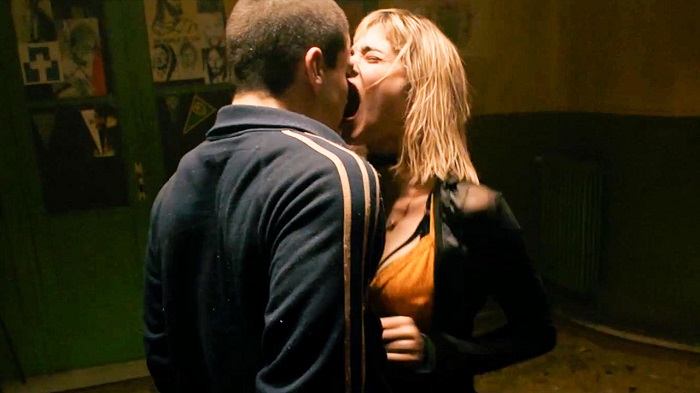
Climax is classic Gaspar Noé, trying to get a reaction any way it can. It’s an impressive bit of technical filmmaking, beautifully ugly in its visual language and chaotically anarchistic with its sound. It’s a story that could be told in about ten minutes, but Noé likes to show off, so he drags it out for another hour and a half. Yep. Classic Noé.
Cinematography

The time that Gaspar Noé saved by not writing a full script for Climax was spent painstakingly blocking and meticulously rehearsing the camera work. With Noé undoubtedly looking over his shoulder, Climax was shot by cinematographer Benoît Debie (who, in addition to having worked on almost all of Noé’s features, also shot Spring Breakers and The Sisters Brothers).
The film is made up mostly of long, drawn out takes that allow Debie’s Steadicam to follow each character around for a while, seamlessly switching points of view by simply latching onto another character á la Martin Scorsese (or Paul Thomas Anderson, or Robert Altman). Aside from a few conversational static camera shots, the whole movie gives the impression that it is one fluid movement, the audience along for the ride like a fly on the wall. It’s quite an impressive feat of cinematography.
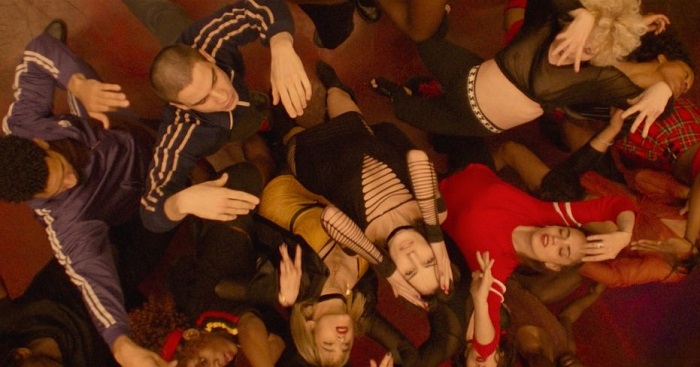
Also impressive is how Noé and Debie capture the dance sequences, both during the choreographed number and the improvised party. The dances are shown from a bird’s-eye view, either from directly overhead with a ceiling camera or from perched high atop a crane. It lets the viewer take in the entire routine, which is great because, after all, the cast is made up of primarily dancers, so it’s fun to see them do their thing. Of course, these are also extended takes, so the momentum of the movie isn’t broken up at all by the dance numbers. Noé cinematic niche lies firmly in his exciting visual style, and Climax lives up to his reputation.
Score and Soundtrack in Gaspar Noé's Climax

Since Climax is basically a document of a warehouse party, a slick playlist of hot tunes is a must for its soundtrack. DJ Kiddy Smile keeps the party rocking with a killer mix of 80s and 90s club hits from the likes of Daft Punk, Aphex Twin, Soft Cell, Marrs, Gary Numan, and Giorgio Moroder. The music never stops, so at times it functions as background noise, but the Climax soundtrack sets the tone and mood of the party (and, therefore, the whole movie) nicely. And, even though the bulk of the songs are more than 20 years old, the mixes and remixes sound just as fresh as the day the needle was first dropped on them.
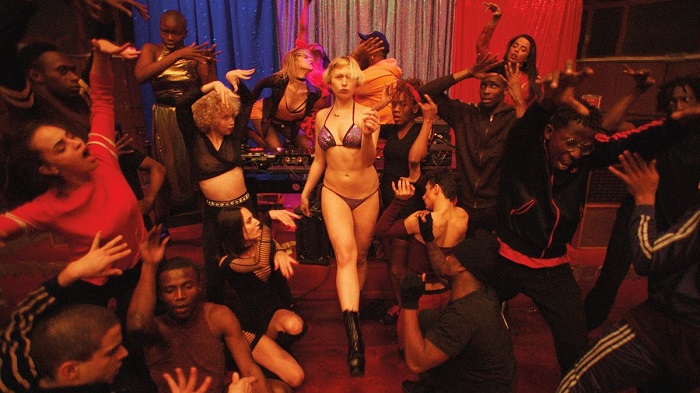
Scary Factor

The movies of Gaspar Noé tend to walk the fringe horror line, and Climax is no exception. It’s being billed as a horror movie, but that’s only because it doesn’t fit in anywhere else. It’s not scary in a traditional sense, more like just very unsettling in its imagery.
A perfect example of this is how all of the seemingly double-jointed male dancers contort their bodies into horrifying and grotesque shapes that are reminiscent of a certain scene from the recent Suspiria remake. Climax also seemingly checks off every trigger box – violence, drug and alcohol abuse, sexual assault, incest, child endangerment, it’s all there. But it’s all presented as part of the bigger picture instead of as main story points. Again, Climax is Gaspar Noé trying to get a reaction from his audience. If that reaction happens to be fear, then that’s what the audience gets.

